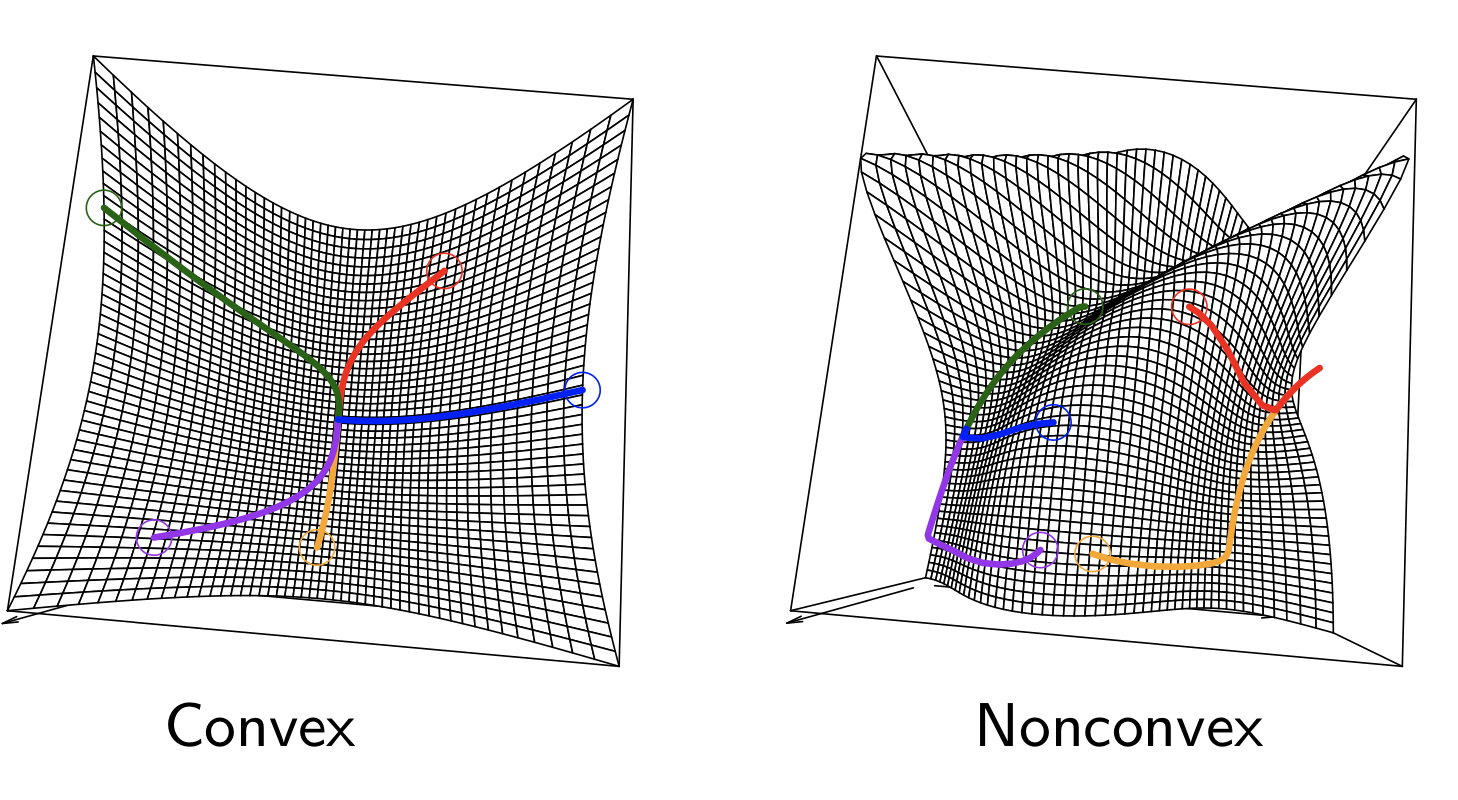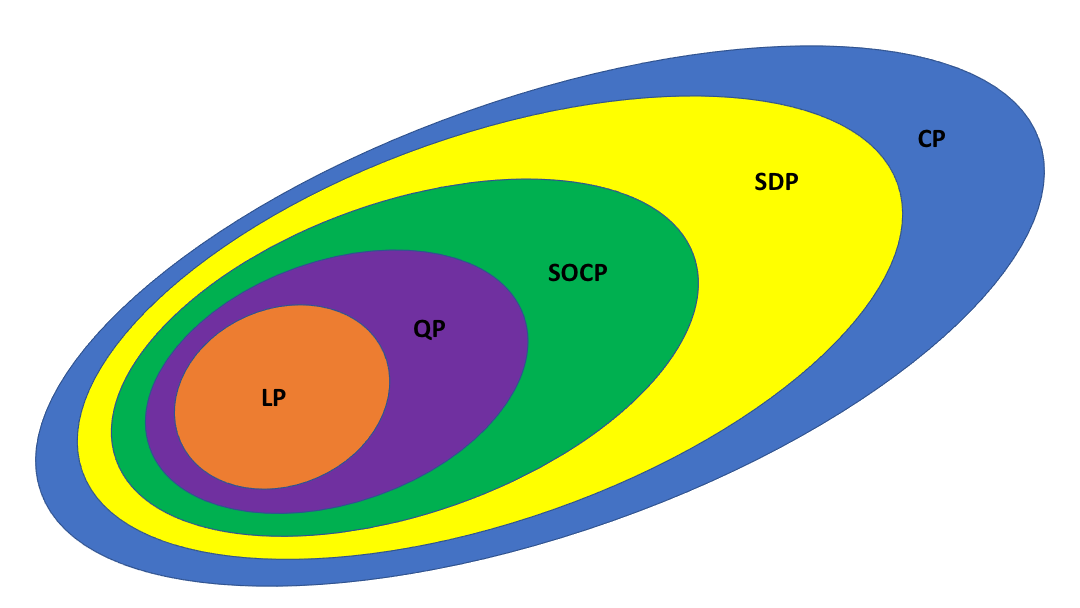class: center, middle, inverse, title-slide # 03 Basics and standard problems ### STAT 535A ### Daniel J. McDonald ### Last modified - 2021-01-18 --- ## Last time * Convexity means local == global, it's good .center[] * Convex sets: `\(x,y \in C \Rightarrow tx + (1-t)y \in C\)` * Convex functions: domain convex and "function lies below a line" * 0th/1st/2nd-order characterizations * Various ways common operations retain convexity (affine transforms, maximum, minimum, etc.) --- ## Today 1. Optimization terminology 2. Properties and first order optimality 3. Equivalent transformations 4. Standard problems $$ \newcommand{\R}{\mathbb{R}} \newcommand{\argmin}[1]{\underset{#1}{\textrm{argmin}}} \newcommand{\norm}[1]{\left\lVert #1 \right\rVert} \newcommand{\indicator}{1} \renewcommand{\bar}{\overline} \renewcommand{\hat}{\widehat} \newcommand{\tr}[1]{\mbox{tr}(#1)} \newcommand{\Set}[1]{\left\{#1\right\}} \newcommand{\dom}[1]{\textrm{dom}\left(#1\right)} \newcommand{\st}{\;\;\textrm{ s.t. }\;\;} $$ --- ## Optimization problem A convex optimization problem (program) $$ `\begin{aligned} \min\limits_{x \in D} &\quad f(x) \\ \text{subject to} &\quad g_i(x) \leq 0 & \forall i \in 1,\ldots, m \\ &\quad A x = b \end{aligned}` $$ where `\(f, g_i\)` are convex and `\(D = \dom{f} \cap \dom{g_i}\)`. --- ## Terms $$ `\begin{aligned} \min\limits_{x \in D} &\quad f(x) \\ \text{subject to} &\quad g_i(x) \leq 0 & \forall i \in 1,\ldots,m \\ &\quad A x = b \end{aligned}` $$ - `\(f\)` -- criterion or objective function. - `\(g_i\)` -- inequality constraints. - `\(x\)` is a **feasible point** if it satisfies the conditions, namely `\(x \in D\)`, `\(g_i(x) \leq 0\)`, and `\(A x = b\)`. - `\(\min f\)` over feasible points -- **optimal value** `\(f^*\)`. --- $$ `\begin{aligned} \min\limits_{x \in D} &\quad f(x) \\ \text{subject to} &\quad g_i(x) \leq 0 & \forall i \in 1,\ldots,m \\ &\quad A x = b \end{aligned}` $$ - If `\(x\)` is feasible and `\(f(x) = f^*\)` then `\(x\)` is an **optimum** (solution, minimizer). - Feasible `\(x\)` is a **local optimum** if `\(\exists R > 0\)` such that `\(\forall y \in B_R(x)\ \ f(x) \leq f(y)\)`. - If `\(x\)` is feasible and `\(f(x) \leq f^* + \varepsilon\)` then `\(x\)` is `\(\varepsilon\)`-suboptimal. - If `\(x\)` is feasible and `\(g_k(x) = 0\)` then `\(g_k\)` is **active** at `\(x\)` (otherwise inactive). -- $$ `\begin{aligned} \max_{x \in D} &\quad -f(x)\\ \text{subject to} &\quad g_i(x) \leq 0 & \forall i \in 1,\ldots,m \\ &\quad A x = b \end{aligned}` $$ Maximization is equivalent Refer to the minimization as **standard form** --- ## Properties 1. The set of feasible points is convex. 2. Solution set `\(X_{opt}\)` is convex, (this is the set of all solutions) Proof: By the definition. -- Suppose `\(x,y \in X_{opt} \subseteq X_{feasible}\)` 1. `\(A(tx+(1-t)y) = tAx + (1-t)Ay = tb + (1-t)b = b\)` 2. `\(g(tx+(1-t)y) \leq tg(x) + (1-t)g(y) \leq 0\)` 3. `\(f(tx+(1-t)y) \leq tf(x) + (1-t)f(y) = f^*\)` -- - If `\(f\)` is strictly convex then the solution is unique. - For convex optimization problems all local optima are global. --- ## Example: Lasso. `\(\min\limits_\beta \left\lVert y - X \beta \right\rVert_2^2\)` subject to `\(\left\lVert \beta \right\rVert_1 \leq s\)`. - `\(g_1(\beta) = \left\lVert \beta \right\rVert_1 - s\)` -- convex, no equality constraints. - `\(X\)` is `\(n \times p\)` matrix - If `\(n \geq p\)` and `\(X\)` is full rank then `\(\nabla^2 f(\cdot) = 2 {X}^\top X\)` is positive definite matrix. The function is strictly convex, therefore the solution is unique. - If `\(p > n\)` then `\(\exists \beta \neq 0\)` such that `\(X \beta = 0\)` `\(\implies\)` there may be multiple solutions. --- ## First Order Condition - convex problem with differentiable `\(f\)` - a feasible `\(x\)` is optimal iff `\(\nabla f(x)^{\top}( x - y) \ge 0\)`, `\(\forall\)` feasible `\(y\)` - if unconstrained, the condition reduces to `\(\nabla f(x) = 0\)` `$$\min\limits_x \frac{1}{2}x^{\top}Q x + b^{\top}x + c, \quad\quad Q \succeq 0$$` - FOC: `\(\nabla f(x) = Q^{\top}x + b = 0\)` - if `\(Q \succ 0\)` `\(\rightarrow\)` `\(x^{*} = -Q^{-1}b\)` - if `\(Q\)` singular, `\(b \notin Col[Q] \rightarrow\)` no solution - if `\(Q\)` singular, `\(b \in Col[Q] \rightarrow\)` `\(x^{*} = -Q^{+}b + z\)` with `\(z \in null(Q)\)` --- class: center, inverse, middle # Useful operations --- ## Rewriting constraints $$ `\begin{aligned} \min_{x \in D} &\quad f(x)\\ \text{subject to} &\quad g_i(x) \leq 0 & \forall i \in 1,\ldots,m \\ &\quad A x = b \end{aligned}` $$ Let `\(C = \{x : g_i(x) \leq 0,\ Ax=b\}\)`. `$$\Longleftrightarrow \min_{x \in C} f(x)$$` `$$\Longleftrightarrow \min_{x \in D} f(x) + I_C(x)$$` --- ## Partial optimization Recall: `\(h(x) = \min\limits_{y\in C}f(x,y)\)` is convex if `\(f\)` is convex, and `\(C\)` is convex. $$ `\begin{aligned} \min\limits_{x_{1},x_{2}} &\quad f(x_{1},x_{2}) &&\min\limits_{x_{1}}&\quad \tilde{f}(x_{1})\\ \textrm{s.t.}&\quad g_{1}(x_{1}) \le 0 &\Longleftrightarrow &\textrm{s.t.}&\quad g_{1}(x_{1}) &\le 0\\ &\quad g_2(x_2) \le 0 \end{aligned}` $$ where `\(\tilde{f}(x_1) = \min\{f(x_1,x_2): g_2(x_2)\le 0\}\)`. - The right problem is convex if the left is (and vice versa) --- ## Transformations - We can use a monotone increasing transformation `\(h: \mathbb{R} \rightarrow \mathbb{R}\)`: `$$\quad \min\limits_{x\in C} f(x) \Rightarrow \min\limits_{x\in C} h(f(x))$$` - We can use a change of variable transformation `\(\phi : \mathbb{R}^{n} \Rightarrow \mathbb{R}^{m}\)` : `$$\quad \min\limits_{x \in C} f(x) \Leftrightarrow \min\limits_{\phi(y) \in C} f(\phi(y))$$` --- ## Example: Geometric Program $$ `\begin{aligned} \min_x &\quad f(x) = \sum\limits_{k=1}^{p}\gamma_{k}x_{1}^{a_{k_1}}x_{2}^{a_{k_{2}}} \ldots x_{n}^{a_{k_{n}}}\quad\quad \textrm{(posynomial)}\\ \textrm{s.t.} &\quad g_i(x) \leq 1\\ &\quad h_j(x) = 1 \end{aligned}` $$ - `\(f\)` and `\(g\)` are posynomials and `\(h\)` are monomials - This is nonconvex -- - We can change above to the following convex problem by letting `\(y_{i} = \log x_{i}\)` $$ `\begin{aligned} \min_x &\quad f(x) = \log\left(\sum\limits_{k=1}^{p_0}\exp(a_{0k}^\top y + b_{0k})\right)\\ \textrm{s.t.} &\quad \log\left(\sum\limits_{k=1}^{p_i}\exp(a_{ik}^\top y + b_{ik})\right) \leq 1\\ &\quad c_j^\top y + d_j = 0 \end{aligned}` $$ - This is a standard problem, (logistic regression, floor planning) --- ## Eliminate equality constraints $$ `\begin{aligned} \min\limits_{x}&\quad f(x) \\ \textrm{s.t.} &\quad g_{i}(x) \le 0\\ &\quad Ax = b \end{aligned}` $$ - `\(x\)` feasible means `\(\exists M : col(M)= null(A)\)` and `\(x_0 \st Ax_{0} = b\)` - Let `\(x=My + x_{0}\)` Then the following is an equivalent problem: $$ `\begin{aligned} \min\limits_{y}&\quad f(My+x_0) \\ \textrm{s.t.} &\quad g_{i}(My+x_0) \le 0 \end{aligned}` $$ --- ## Introduce slack variables $$ `\begin{aligned} \min\limits_{x}&\quad f(x) \\ \textrm{s.t.} &\quad g_{i}(x) \leq 0\\ &\quad Ax = b \end{aligned}` $$ - Can add equality constraints: $$ `\begin{aligned} \min\limits_{x,s}&\quad f(x) \\ \textrm{s.t.} &\quad g_{i}(x) + s_i = 0\\ &\quad s_i \geq 0\\ &\quad Ax = b \end{aligned}` $$ - But this is nonconvex unless `\(g_i\)` are affine --- __Relaxation__ We can relax nonaffine constraints `$$\min\limits_{x \in C} f(x) \Rightarrow \min\limits_{x \in \tilde{C} } f(x)$$` with `\(C \subset \tilde{C}\)` - In this case optimum of new problem is smaller or equal to the optimum of the original problem. -- $$ `\begin{aligned} \min\limits_{x,s}&\quad f(x) \\ \textrm{s.t.} &\quad g_{i}(x) + s_i \leq 0\\ &\quad s_i \geq 0\\ &\quad Ax = b \end{aligned}` $$ --- class: middle, inverse, center # Standard problems --- ## LP (Linear Programs) `$$\min_{x} c^{\top}x\qquad \mbox{s.t.}\qquad x\geq 0,\ Ax=b \qquad \mbox{(standard form)}$$` - Basis Pursuit (not an LP) `$$\qquad \min\limits_{\beta} \| \beta \|_0\quad \mbox{s.t.}\quad X \beta = y$$` - Above problem can be relaxed to `$$\qquad \min\limits_{\beta} \| \beta \|_{1}\quad \mbox{s.t.}\quad X \beta = y$$` - This relaxation can be reformulated as an LP problem: `$$\qquad \min\limits_{\beta, z} 1^{\top}z\quad \mbox{s.t.}\quad z \ge \beta, z \ge -\beta, X\beta = y$$` - Dantzig selector `$$\qquad \min\limits_{\beta} \| \beta \|_{1}\quad \mbox{s.t.}\quad \|X^{\top}(y - X\beta)\|_{\infty} \le \lambda$$` --- ## QP (Quadratic program) $$ `\begin{aligned} \min_x &\quad c^\top x + \frac{1}{2}x^\top Q x\\ \textrm{s.t.}&\quad x \geq 0\\ &\quad Ax = b \end{aligned}` $$ Lasso, ridge regression, OLS, Portfolio Optimization, support vector machines -- Some work to rewrite in this form, but it can be done --- ## SDP (Semi-Definite program) $$ `\begin{aligned} \min\limits_{X \in S_{n}} &\quad \tr{C^{\top}X}\\ \textrm{s.t.}&\quad \tr{A_{i}^{\top} X} = b_{i}\\ &\quad X \succeq 0 \end{aligned}` $$ -- Trace norm minimization $$ `\begin{aligned} \min_X &\quad \tr{X}\\ \textrm{s.t.}&\quad \tr{A_{i}^{\top} X} = b_{i} \end{aligned}` $$ (Find the "lowest" rank solution to an underdetermined system.) --- ## Conic program $$ `\begin{aligned} \min\limits_{x} &\quad c^\top x\\ \textrm{s.t.}&\quad Ax=b\\ &\quad D(x) + d \in K \end{aligned}` $$ `\(D\)` a linear mapping, `\(K\)` a closed convex cone. - Generalization of an LP (take `\(K=\R^n_+\)`) or SDP (take `\(K = \mathcal{S}^n_+\)`) ## Second order cone program $$ `\begin{aligned} \min\limits_{x} &\quad c^\top x\\ \textrm{s.t.}&\quad Ax=b\\ &\quad \| D_i x + d_i \|_w \leq e_i^\top x + f_i \end{aligned}` $$ - also a special case conic program --- ## Relations .center[  ]